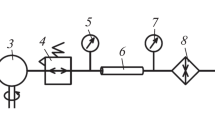Abstract
The wear of steel plates under the impact of a hydroabrasive jet was studied experimentally by varying the distance between the sample surface and the nozzle, the angle of impingement of the jet on the plate, and the abrasive concentrations in water and in the ambient medium (jet in air, submerged jet). The results are compared with available data on the structure of the jet and jet flow around an obstacle. It is shown that the addition of abrasive particles to the liquid can be used to study the liquid jet flow around an obstacle because the form of surface wear allows one to determine the region of impact of the jet core, the deceleration region, and the near-wall flow region before flow separation.
Similar content being viewed by others
References
V. S. Kombalov, “Methods and Means for Friction and Wear Tests of Structural and Lubricant Materials,” Ed. by K. V. Frolov and E. A. Marchenko (Mashinostroeniye, Moscow, 2008) [in Russian].
N. I. Smirnov and N. N. Smirnov, “Method for Testing Materials for Hydroabrasive and Corrosive Wear,” RF Patent No. 2444719, IPC G 01 N 3/56, Publ. 03.10.12, Byul. No. 7.
A. A. Shtertser, V. Yu. Ulianitsky, K. A. Tsarakhov, and B. E. Grinberg, “Characterization of Detonation Sprayed Coatings,” in Proc.of the Int. Thermal Spray Conf., Hamburg, 27–29 Sept., 2011 (DVS Media GmbH, Duesseldorf, 2011), pp. 1036–1038.
L. D. Landau and E. M. Lifshits, Course of Theoretical Physics, Vol. 6: Fluid Mechanics (Nauka, Moscow, 1986; Pergamon Press, Oxford-Elmsford, New York, 1987).
M. Van Dyke (assemb.), An Album of Fluid Motion (Parabolic Press, Stanford, 1982).
L. Rayleigh, “On the Instability of Jets,” Proc. London Math. Soc. 10, 4–13 (1879).
Yu. G. Chesnokov, “Nonlinear Development of Capillary Waves in a Viscous Liquid Jet,” Zh. Tekh. Fiz. 70(8), 31–38 (2000).
Yu. G. Chesnokov, “Short Capillary Waves on the Surface of the Sprawling Cylindrical Jet of a Viscous Liquid,” Prikl. Mekh. Tekh. Fiz. 42(3), 56–52 (2001) [J. Appl. Mech. Tech. Phys. 42 (3), 431–436 (2001)].
G. N. Abramovich, Theory of Turbulent Jets (Fizmatgiz, Moscow, 1960) [in Russian].
K. N. Volkov, “Interaction of a Circular Turbulent Jet with a Flat Obstacle,” Prikl. Mekh. Tekh. Fiz. 48(1), 55–67 (2007) [J. Appl. Mech. Tech. Phys. 48 (1), 44–54 (2007)].
I. Kleis and P. Kulu, Solid Particle Erosion. Occurrence, Prognosification and Control (Tallinn Univ. Technol., Tallinn, 2005).
Author information
Authors and Affiliations
Corresponding author
Additional information
Original Russian Text © A. A. Shtertser, B. E. Grinberg.
__________
Translated from Prikladnaya Mekhanika i Tekhnicheskaya Fizika, Vol. 54, No. 3, pp. 191–201, May–June, 2013.
Rights and permissions
About this article
Cite this article
Shtertser, A.A., Grinberg, B.E. Impact of a hydroabrasive jet on material: Hydroabrasive wear. J Appl Mech Tech Phy 54, 508–516 (2013). https://doi.org/10.1134/S002189441303022X
Received:
Revised:
Published:
Issue Date:
DOI: https://doi.org/10.1134/S002189441303022X




